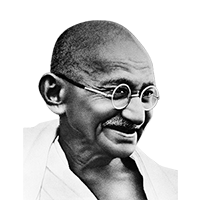Biography of Mahatma Gandhi
Mahatma Gandhi was the national leader of India, the main pillar of the freedom struggle and the pioneer of non-violence. His full name was Mohandas Karamchand Gandhi, but the countrymen lovingly honored him by calling him “Bapu” and “Father of the Nation”. Gandhiji not only freed India from the slavery of the British, but he showed a new direction to the whole world by following the path of truth, non-violence and simplicity.
In this article we will learn in detail about the life of Mahatma Gandhi, his struggles, ideology and his contribution to the Indian freedom movement.
agvp-auwo-ioun-jjej-ildn
Early Life (1869–1888)
Birth and Family
Mohandas Karamchand Gandhi was born on 2 October 1869 at a place called Porbandar in Gujarat. His father Karamchand Gandhi was the Diwan of Porbandar state and mother Putlibai was a religious woman. Gandhiji’s family belonged to the Modh Bania community and followed Vaishnav Hindu traditions.
Childhood and Education
Mohandas was an average student, but he had a deep understanding of moral values. His early education took place in Porbandar and Rajkot. At the age of 13, he was married to Kasturba Gandhi (Kasturbai Makhanji), who was a year older than him.
After passing the matriculation examination in 1887, Gandhiji took admission in Samaldas College in Bhavnagar, but there he had difficulty in English education. As per the wishes of the family, he decided to go to England to study law.
Education in England (1888–1891)
On 4 September 1888, Gandhi arrived in London and joined the Inner Temple Law College. There he studied law and became a barrister. While in England, he studied vegetarian food, Western civilization and Christianity. Returning to India in 1891, he started practicing law, but was not successful in litigation.
Struggle in South Africa (1893–1914)

Facing apartheid
In 1893, Gandhi had to go to South Africa to plead the case of an Indian merchant Dada Abdullah. There he faced deep apartheid and discrimination.
Pietermaritzburg incident: While travelling in a first class train, a white passenger asked him to move to the third class compartment. When Gandhi refused, he was forcibly removed from the train.
Injustice towards black people: Indians and blacks in South Africa were denied the right to vote, entry into public places and a dignified life.
Beginning of Satyagraha
These experiences inspired Gandhi to raise his voice against social injustice. He founded the Natal Indian Congress (1894) and began the struggle for the rights of Indians.
1899–1902: During the Boer War, he inspired Indians to join the Ambulance Corps.
1906: The “Black Act” (Thumb Impression Law) was implemented against Indians in Transvaal. Gandhiji started Satyagraha (non-violent resistance) against it.
1913: He led the “Great March” against the injustice done to Indian workers, after which the South African government recognized the rights of Indians.
Lessons learnt from South Africa
In South Africa, Gandhiji developed the policy of non-violence, Satyagraha and mass struggle, which were later applied in the Indian freedom movement.
Contribution in Indian freedom struggle (1915–1947)
Return to India and early activities (1915–1919)
Gandhi returned to India in 1915 and joined the national movement under the guidance of Gopal Krishna Gokhale.
Jallianwala Bagh Massacre and Non-Cooperation Movement (1919–1922)
On 13 April 1919, hundreds of people were killed when unarmed demonstrators were fired upon at Jallianwala Bagh in Amritsar on the orders of General Dyer. This incident inspired Gandhi to take a tough stand against the British government.
In 1920, he launched the Non-Cooperation Movement
After the Chauri Chaura incident (violent incident) in 1922, Gandhiji withdrew the movement.
Salt Satyagraha and Dandi March (1930)
In 1930, Gandhi started the Dandi March against the British government’s salt law. In this journey which lasted from 12 March to 6 April, he covered a distance of 240 miles and broke the law by making salt from sea water. This movement was non-violent, but the British government arrested thousands of people.